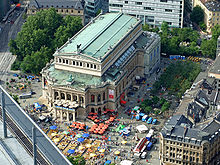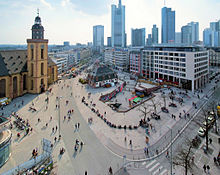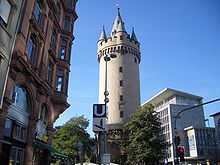Frankfurt city center
|
Inner city 2nd district of Frankfurt am Main |
|
|---|---|
| Coordinates | 50 ° 6 '49 " N , 8 ° 40' 54" E |
| surface | 1.491 km² |
| Residents | 6599 (Dec. 31, 2019) |
| Population density | 4426 inhabitants / km² |
| Post Code | 60313, 60311 |
| prefix | 069 |
| Website | www.frankfurt.de |
| structure | |
| District | 1 - downtown I. |
| Townships |
|
| Transport links | |
| Federal road |
|
| Train | S1 S2 S3 S4 S5 S6 S8 S9 |
| Tram and subway | U1 U2 U3 U4 U5 U6 U7 U8 11 12 14 |
| bus | 30 31 36 n1 n2 n3 n4 n5 n7 n8 n11 n31 n32 n61 n62 n63 n71 |
| Source: Statistics currently 03/2020. Residents with main residence in Frankfurt am Main. Retrieved April 8, 2020 . | |
The city center or Neustadt is the central district of Frankfurt am Main . It extends to the north and east around the Altstadt district . Other neighboring districts are the Bahnhofsviertel in the west, the Westend in the northwest , the Nordend in the north and the Ostend in the east . In the south, the district is bounded by the Main , on the opposite bank of the river is the Sachsenhausen district . The population is 6,599.
The city center and the old town form the right- Main urban area within the Frankfurt ramparts and can therefore be clearly seen on the city map.
The skyscrapers of the banking district offer a contrast to the parks . In the city center there is also the Zeil , one of the largest German shopping streets, boulevards such as Kaiserstraße and Große Bockenheimer Straße (“ Freßgass ”), the street ravine Neue Mainzer Straße and central squares such as the Hauptwache , Konstablerwache or Roßmarkt . The many well-known buildings in the district include the Alte Oper , the Hauptwache, the Eschenheimer Turm , the Stock Exchange , the Palace of Justice , the Hotel Frankfurter Hof , large department stores such as the Zeilgalerie and high-rise buildings such as the Commerzbank Tower or the Main Tower .
Quarters and quarters, streets and squares
The city center is divided into the following quarters from west to east:
Financial district
The banking district lies on both sides of the Taunusanlage and is thus divided between the city center, station district and Westend district. Most of the credit institutions in the eastern banking district are located on Neue Mainzer Straße , Große Gallusstraße , Junghofstraße and the surrounding streets. All the streets mentioned are locations of high-rise buildings, the highest of which is the 300-meter-high Commerzbank Tower (with antenna) . The “high-rise gorge” on Neue Mainzer Strasse is particularly impressive.
The southern part of the district shows a greater variety of uses, especially along Kaiserstraße and Kaiserplatz . Here is the Frankfurter Hof , one of the most famous hotels in the city. In the Großer Hirschgraben , the border to the old town, lies one of the city's cultural highlights, the Goethe House .

Opera district
The main axis of the north-western quarter of the city center is Grosse Bockenheimer Strasse, which runs from Rathenauplatz to Opernplatz , and is better known as Freßgass because of the many dining options . Goethestrasse , which runs parallel to the south, is the city's most expensive shopping street. Opernplatz, located in the ramparts, is one of the most beautiful city squares in Frankfurt. The historic building of the former Frankfurt Stock Exchange is located on the Schillerstraße shopping street with its floor trading (today Deutsche Börse AG , based in Eschborn / Taunus).
The sequence of squares Rathenauplatz-Goetheplatz- Roßmarkt form the transition to the neighboring district around the Zeil.
The streets around the Freßgass are one of the focal points of Frankfurt's nightlife. In the Kleine Bockenheimer Straße there is an important cultural institution with the Jazzkeller and on the Roßmarkt with the U60311 an internationally renowned techno club in a disused pedestrian underpass.
Zeil and the surrounding area
The Zeil pedestrian zone and its two endpoints, Hauptwache and Konstablerwache, are the focal point of Frankfurt's shopping city. In addition to the large department stores, there are shopping centers such as the Zeilgalerie and the MyZeil . Other important streets begin at Hauptwache, such as Roßmarkt, Steinweg , Schillerstraße or Große Eschenheimer Straße . In the latter were the Palais Thurn und Taxis , which was reconstructed, as well as important post-war buildings such as the telecommunications high-rise (demolished in 2005) and the Rundschau-Haus, which was demolished in 2006 . At its northern end is the Eschenheimer Tower , a relic of the late medieval city fortifications. At the Hauptwache is the Katharinenkirche , the main Protestant church of Frankfurt, at the Bleichstrasse the Peterskirche with its preserved cemetery, the only green space in the district. The area between Konstablerwache and Alter Gasse is the center of the gay and lesbian community in Frankfurt. The city's central library and the Kleinmarkthalle Frankfurt are located in Hasengasse .
Judicial district
The northeastern city center is bounded by the eastern half of the Zeil, Konrad-Adenauer-Strasse and Friedberger Anlage. Here, in the Palace of Justice in Heiligkreuzgasse and numerous other buildings, the Higher Regional Court , the Regional Court and a pre-trial detention center are located. Several vocational schools are located in a 1950s high-rise on Seilerstrasse.
Frankfurt's most famous variety show , the Tigerpalast, is located in Heiligkreuzgasse . The Odeon in the Anlagenring on Seilerstraße is a classical exhibition pavilion built in 1808 for Simon Moritz von Bethmann . Today there is a discotheque here .
All Saints District
The small quarter lies between Zeil and Battonnstrasse and is an ethnically mixed city quarter. In addition to the Bahnhofsviertel, the Breite Gasse forms a second red-light district in Frankfurt. There are several municipal offices on Langen Strasse. Kurt-Schumacher-Strasse, which was newly laid out during the reconstruction, is in the area of the former Jewish quarter .
The neighborhood has had a drug (soft drug) and drug dealing problem for years. Some residents no longer dare to go out into the street at night. The police want to get the issue under control with a comprehensive concept that includes surveillance cameras. The installation of surveillance cameras is the subject of intense political discussions.
Fischerfeldviertel
The southeastern quarter of today's inner city was originally at the gates of the city, south of the so-called Judeneck . Because of its marshy terrain, it was not initially integrated into the city fortifications and was bordered both to the west and north by the moat in front of the city wall, the relic of which is the Rechneigrabenweiher. From 1793, the area known as the New Plant was gradually drained and built on.
The quarter owes its name to the fishermen who landed here in the late Middle Ages with their boats outside the protective city walls to service them, reload their catch and mend their nets.
The central facilities of the Frankfurt employment agency , the Diakonische Werk, the Evangelical Hospital for palliative medicine (hospice), the Free Theater, Radio X-mix, the regional SPD party office, the Hospital of the Holy Spirit and the Frankfurt Literature House are located in the Fischerfeldviertel .
history
The settlement of the new town
Until the 14th century, the area of today's inner city was outside the city walls . Despite the unprotected location, construction has already started here. So a row of houses was built north of the walled city on an area used as a cattle market, which gave the street that emerged from this market its name: Zeil . To the east and west of it, at the Bockenheimer and Bornheimer Pforte , country roads ran from the city gates to the surrounding area, where houses and gardens were already being built.
The Neustadt was founded in 1333, when Emperor Ludwig the Bavarian authorized the Free Imperial City to triple its area. The city then built new fortifications with five land-side city gates: the Gallustor (also Mainzer or Galgentor) on today's Willy-Brandt-Platz , the Bockenheimer Tor on today's Opernplatz , the Eschenheimer Tor , the Friedberger Tor and the Allerheiligentor . In the course of the following years, the new urban area was filled with streets and buildings, with rich cloth merchants in particular taking the opportunity to build representative domiciles outside the confines of the old town. In 1428 the Eschenheim Tower , the most magnificent city gate of the new fortification, was completed.
The first churches in Neustadt were two small chapels near the Bockenheimer Pforte: the Heiligkreuzkapelle of a hospital for the poor in 1346 and the neighboring monastery chapel of Saints Katharina and Barbara in 1354. The large Katharinenkirche emerged from the latter in the 17th century . In the north of the new town, the Peterskirche was built from 1381 , which had been the parish church of the new town since 1453. In 1452 a cemetery was set up there, which was the only right Main cemetery in the city after the cathedral churchyard was closed in 1508. Until the opening of today's main cemetery in 1828, the Peterskirchhof, which was expanded several times, remained the most important cemetery in the city. In 1453 another church was built in the Neustadt, the Maternkapelle am Roßmarkt .
In the 15th century there were still numerous undeveloped areas and many gardens in the new town. The old town was still the preferred part of the city at that time, the new town was mainly populated by immigrants pouring into the growing town from the countryside. In the 16th century, the old moat between the old and new towns was filled in, the last of which was the Hirschgraben in 1584.
Noble bourgeois buildings
In the period that followed, the balance between the old and new towns gradually shifted, and new townhouses for wealthy citizens were now being built mainly in the new town. They often served as quarters for the electoral delegations during the imperial coronations taking place in Frankfurt. The most famous city palace was the Palais Thurn und Taxis in the Große Eschenheimer Straße in 1737 . A few years earlier, in 1730, the main guard building , which is still preserved today, was built in the heart of the new town. In the 18th century in particular, prestigious town houses and palaces were built on the Zeil, and from 1742 Palais Barckhausen was even the imperial residence for three years, as the Wittelsbacher Charles VII was unable to move into his Munich residence due to the war with Austria.
Even in classicism , there was brisk construction activity in the Neustadt, the most famous town house of that era is the Goethe House in Großer Hirschgraben. In 1755 an urban stables was built on the Roßmarkt . In 1782 the Komödienhaus , the first permanent theater building in Frankfurt, opened at today's Rathenauplatz (then Theaterplatz) . In 1792, the construction of the Fischerfeld in the southeast of the Neustadt began according to plans by city architect Johann Georg Christian Hess . The most important of the buildings to be built there was the city library on the banks of the Main, designed by Heß and opened in 1825 .
In 1804, during the coalition wars accompanied by permanent occupations by the French , the council decided to demolish the city fortifications. In the course of the following years, the ramparts that have been preserved to this day were built in their place . The Wallservitut issued in 1807 protects the facilities from development.
In 1833 the Neustadt became the scene of revolutionary events: the Frankfurt guard tower on the main guard and constable guard . The Frankfurt National Assembly met in 1848/49 in the Paulskirche in the old town, the largest and most modern hall in the city at the time, but the various factions mainly meet in the districts and cafes of the new town.
In 1844 the Goethedenkmal was erected on the Roßmarkt, which stood in the Gallusanlage from 1952 to 2009 and has graced the newly designed Goetheplatz since 2009. In 1858 a memorial for Johannes Gutenberg followed , also on the Roßmarkt, in 1864 one for Friedrich Schiller , which initially stood at the Hauptwache, from 1878 on the Goetheplatz and since 1955 in the Taunusanlage. Only late in 1908 did the city decide to build a Bismarck memorial: it was erected in the Gallus complex and melted down in 1940. In 1859 Frankfurt citizens built the hall in Junghofstrasse as a festival and concert hall. In 1860 the new main synagogue was inaugurated in Börnestrasse , and another followed in 1882 on Börneplatz .
The Neustadt as a modern city center
After the annexation by Prussia as a result of the German War in 1866, Frankfurt quickly developed into a modern, Wilhelminian-style city. The previously quite wide-meshed road network of the Neustadt was condensed by road openings, wide boulevards were created. From 1870 onwards - based on the Parisian model - Kaiserstraße and Kaiserplatz were created as a connection between the Hauptwache and the Westbahnhöfen . In 1876 the Hotel Frankfurter Hof opened on Kaiserplatz , henceforth the “First House on the Square”. The Neue Zeil, Schillerstraße and Goethestraße are created through further breakthroughs. In 1874 the Untermainbrücke , which was an extension of Neue Mainzer Straße, was completed, and in 1878 the Obermainbrücke followed along Langen Straße. In 1879 the new building of the new stock exchange opened near the main guard. In 1880 the opera house , built with donations from Frankfurt citizens, was inaugurated. In 1889 the new Palace of Justice opened in Heiligkreuzgasse, and in 1902 the theater in Untermainanlage.
The rapid growth processes in the Neustadt led to the formation of a city , the previous residential quarters developed into a metropolitan commercial and business center, the previous residents were pushed into the emerging suburbs. The horse-drawn tram operated by the Frankfurt Tramway Company has been running through the Neustadt since 1872 , which now represented the unambiguous city center and thus completely overtook the old town, which was largely decoupled from urban development. The tram operation was taken over by the city tram Frankfurt am Main in 1897 and switched to electric operation in 1899, giving the city a modern and efficient means of transport. The central traffic junction of the tram was at the Hauptwache, numerous lines ran over the Zeil, which developed into the street of the large department stores.
In the years after the First World War , the focus of urban development shifted more to the outer districts. The late nineteenth downtown fell in World War II , as well as the Gothic Old Town, 1943-44 numerous Allied air raids victim.
The reconstruction primarily took into account the needs of urban traffic and the assumptions of modern urban planning at the time. Completely new traffic axes, such as Konrad-Adenauer-Straße, were laid through the rubble field, while other streets, such as the Zeil, were considerably widened. The rebuilding of the inner city dragged on until the late 1960s. The underground construction changed from 1963, again the cityscape of downtown, after long large construction projects, the large underground Quick stations were built at the Hauptwache and Konstablerwache. On the Zeil and Fressgass were pedestrian zones set up, most tram lines to 1986 shut down . In the western inner city, a banking district based on the model of American central business districts was formed . Numerous high-rise buildings have been built here since the early 1970s, of which the BfG high-rise on Willy-Brandt-Platz and the Commerzbank Tower on Kaiserplatz are among the most famous.
Sights and cultural monuments
Web links
- Frankfurt city center at par.frankfurt.de , the former website of the city of Frankfurt am Main
Individual evidence
- ↑ Katharina Iskandar: Allerheiligenviertel: Nobody wants to go out into the streets at night . In: Frankfurter Allgemeine Zeitung . August 2, 2017, ISSN 0174-4909 ( faz.net [accessed August 2, 2017]).








